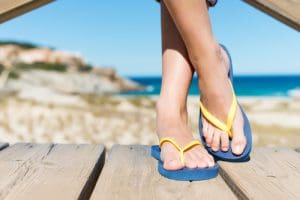 As the winter sports season draws to an end and summer approaches, flip-flop season springs into fashion. During this time of the year, people tend to become keenly aware of their foot’s overall structure and appearance. An astonishing 23 percent of Americans between the ages of 18-65 suffer from a bunion, making it one of the more common foot problems.
As the winter sports season draws to an end and summer approaches, flip-flop season springs into fashion. During this time of the year, people tend to become keenly aware of their foot’s overall structure and appearance. An astonishing 23 percent of Americans between the ages of 18-65 suffer from a bunion, making it one of the more common foot problems.
What Are Bunions?
Bunions are a progressive deformity caused by mechanical instability of the foot with excess stress placed on the big toe joint. You may notice on the side of your big toe a bony protuberance, swelling, and your great toe starting to drift towards your other toes. Commonly people will notice pain when in closed toe shoe gear, sometimes becoming so severe it limits their ability to walk. Unfortunately, bunions tend to get worse as time goes on, which can cause your other toes to be affected.
How Are Bunions Treated?
The way bunion deformities are treated depends on your pain level. Non-surgical options are aimed at pain reduction, but they do not reverse the deformity. Non-surgical options include padding, shoe gear modification, shoe inserts, and anti-inflammatory medications. When the pain level and deformity of the bunion have passed the limits of non-surgical options, surgery may be recommended. Procedural selection for a bunion is done by a combination of in office physical assessment with radiographic examination. Furthermore, procedural selection also takes into account your activity level, age, and the care level each individual needs. Most bunion surgery is an outpatient same day surgical procedure. Following the surgical procedure you will be placed in either a surgical shoe or a cast. The length of recovery after surgery depends on procedural selection.
Treating Bunions at the Center for Spine and Orthopedics
At the Center for Spine and Orthopedics, I take great care in dealing with bunion deformities and pain. When you come to our office, I make sure to explain each physical and radiographic finding to you in detail. We as a team will come up with the best treatment option suited to you.
–Eric Kuhlman, DPM
For more information or an appointment with Dr. Kuhlman, call the Center for Spine and Orthopedics at 303-287-2800.








